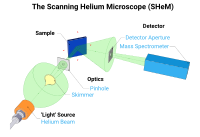Atomic nanoscope

An atomic nanoscope is a fancy tool that helps scientists see things that are too tiny for us to usually see with our eyes or regular microscopes. When we look at something under a regular microscope, we can see things that are bigger than a few nanometers. But sometimes we need to see things that are much smaller than that, like atoms and molecules.
The atomic nanoscope is made up of different parts that work together to do this. The main part is a tiny probe that is so small it can fit on the tip of a needle. This probe can scan across the surface of the tiny thing we want to see, like a molecule. As it scans, it sends tiny electrical signals back to a computer. The computer takes all these signals and turns them into a picture that shows us what the molecule looks like.
Imagine if you were trying to make a drawing of a tiny bug that was too small for you to see properly. You could use a special magnifying glass to see the bug closer up, but it might still look blurry. But if you had a really fancy tool that could scan over the bug and take pictures of it, you could see all the details and create a really great drawing. That's kind of what an atomic nanoscope does, but with things that are way, way smaller than any bug you've ever seen. It helps scientists learn more about things that are too small for us to normally see, which can help us understand how the world works.
The atomic nanoscope is made up of different parts that work together to do this. The main part is a tiny probe that is so small it can fit on the tip of a needle. This probe can scan across the surface of the tiny thing we want to see, like a molecule. As it scans, it sends tiny electrical signals back to a computer. The computer takes all these signals and turns them into a picture that shows us what the molecule looks like.
Imagine if you were trying to make a drawing of a tiny bug that was too small for you to see properly. You could use a special magnifying glass to see the bug closer up, but it might still look blurry. But if you had a really fancy tool that could scan over the bug and take pictures of it, you could see all the details and create a really great drawing. That's kind of what an atomic nanoscope does, but with things that are way, way smaller than any bug you've ever seen. It helps scientists learn more about things that are too small for us to normally see, which can help us understand how the world works.
Related topics others have asked about:
